by TRA
The History of the Pentacon Six
The Praktisix
Dates: 1956 (prototypes only); 1957-1964
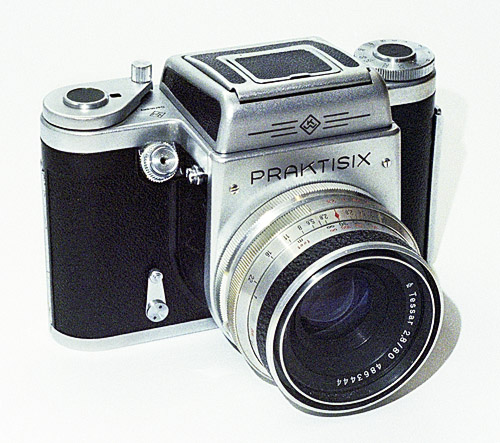
Note the KW logo on the camera’s top plate and on the
front of the
“waist-level” finder.
Underneath the logo on the top plate is the word
“Germany” – not
“GDR”,
“DDR” or “German Democratic Republic”,
terms which were only introduced widely in about 1963
after the building
of the Berlin Wall.
(See clearer picture of this here.)
This example of the camera is fitted with 80mm Carl
Zeiss Jena Tessar
lens, which was an optional upgrade.
Note the lack of any cover on the frame number window
within the film
advance lever.
[C396_7.jpg]
KW’s advertising described the new PRAKTISIX medium format camera as “Ein Meisterstück Deutscher Präzisionsarbeit” (“A masterpiece of German precision manufacturing”). Perhaps there was in this slogan a deliberate echo of the name of the previous Medium Format SLR that had been in its final months assembled by KW: the Meister-Korelle.
The Praktisix was a medium format single lens reflex camera delivering 12 2¼ square (6 × 6 cm) negatives on 120 rollfilm, with a horizontal-travel rubberised cloth focal plane shutter speeded from 1 second to 1/1000, plus B, with X flash synchronisation. The camera had a flat base (no protruding spool knobs) and the lower spool holder at each side could be bent down on a spring-loaded arm once the back was open, to facilitate film loading. Jehmlich states (p. 78) that the Praktisix was in 1957 the first Medium Format SLR in the world with automatic aperture control (“ASB” – Automatische Springblende).
Totally unlike the vertical box shape of well-established Rollei twin-lens medium-format camera and the short-lived 1950s “Exakta 66” (see below), like the Korelle models and the 35mm Praktina, the Praktisix transported the film horizontally and was more reminiscent of 35mm single-lens reflex cameras. The “British Journal of Photography” review of 10 December 1965 said, “... most users would find the Praktisix the quickest in action of all 6 × 6 SLR’s, handling in this respect very similarly to a 35 mm camera.”
| Features
When this camera was launched
in 1956, the publicity described
it as “fully automatic”, which at that time
appeared to mean:
It was of course supplied with a waist-level finder and standard lens only, but the manufacturer’s literature described its features as including:
There was a film speed memo dial in ASA and DIN on the back. This had to be set from inside the camera before loading film. |
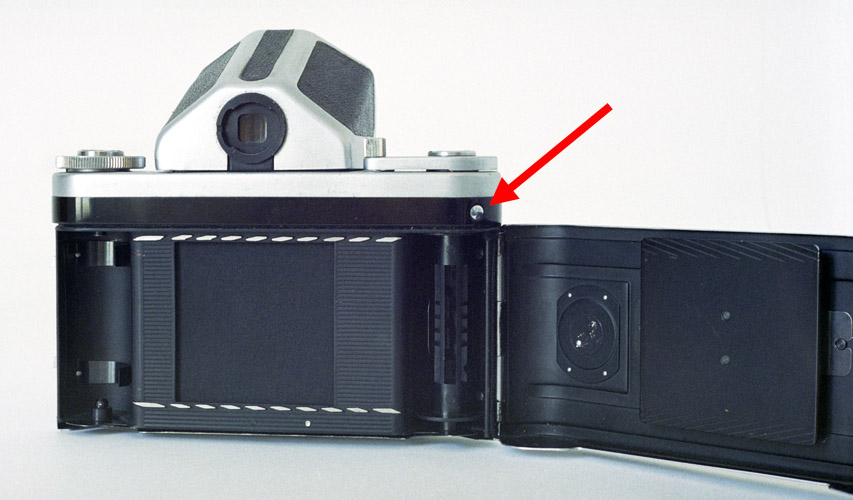
Inside the Praktisix. [C447_30A.jpg]
|
| Lenses
The first publicity did not show any lenses, but stated that interchangeable lenses in focal lengths from 60 to 300mm were planned, using the “proven Praktina screw bayonet”. In fact, no 60mm lens was ever offered. The widest that was soon thereafter available was the slightly less wide 65mm Flektogon, introduced in September 1956. The standard lens was initially an 80mm f/3.5 Meyer-Optik Primotar E or an 80mm Zeiss Tessar. The Primotar had an automatic diaphragm (actuated by a lever in the camera throat pressing on the diaphragm pin), but it also had the pre-set ring that enabled the user to open to full aperture for focussing and then stop down quickly to the pre-set aperture without having to look at the lens, before firing. In practice, this can be justified as providing a depth-of-field check, as neither the camera body nor the lens has a depth-of-field lever. The lens focussed to a close 0.8 m and stopped down to f/16 The four-element f/2.8 80mm Tessar from Carl Zeiss, Jena was produced in the Praktisix mount from at least September 1956 (Thiele, p 240). This had the automatic diaphragm pin and the tiny stop-down lever that will be familiar to all owners of the subsequent 80mm Biometar. It focussed down to fractionally under 1 meter and stopped down to f/22. By 1958 there was a prism viewfinder and the manufacturer’s literature now stated that lenses from 65mm to 300mm were planned. From March 1959 the five-element f/2.8 80mm Biometar from Carl Zeiss Jena became available in the Praktisix mount. This subsequently became the standard lens supplied with the camera and its successors. The first 50mm Flektogons began to be produced in very small numbers in 1960. |
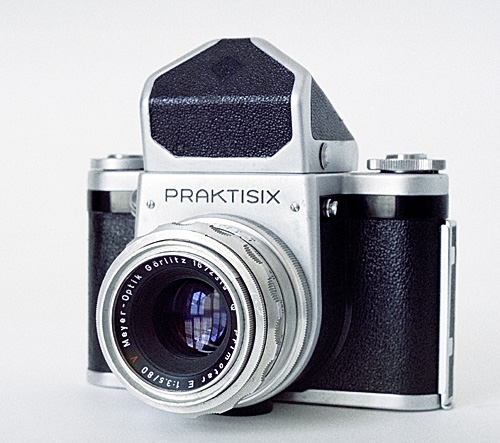
The Praktisix with the 80mm Meyer Primotar E This Praktisix has one of the first prisms that were available for the camera, as can be seen from the KW logo, the dark diamond background of which is just about distinguishable on its front surface. [C447_29A.jpg] |
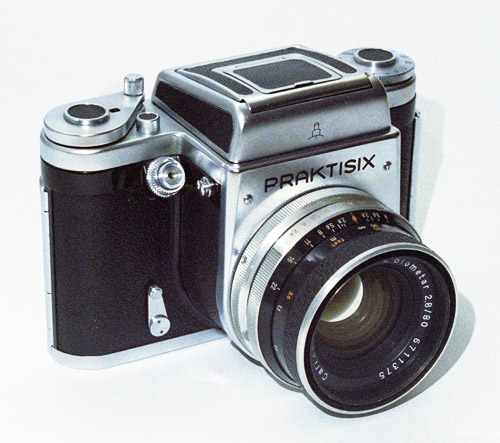
A later version of the Praktisix. [C396_8]
|
By 1959 the extension tubes and
the bellows were being
advertised, as well as the special pressure
plate for photographic
glass plates, preferably 6.5 × 9 cm (for single
exposures).
By 1962, if not earlier, the magnifying finder was available and by 1962 the lens range was from 50mm to 1000mm, although the longest lens with automatic diaphragm was the 180mm Zeiss Sonnar. The only 300mm lens at the time was the manual (pre-set) Meyer Telemegor with a maximum aperture of f/4.5. There was at the time no 500mm lens. Factory literature from 1963 shows four accessories for the prism:
In 1959 VEB Kamerawerke
Niedersedlitz, East Germany, became
part of the VEB Kamera- und Kinowerke Dresden,
which in turn became part
of Kombinat VEB Pentacon in 1968. This
led to the gradual disappearance
of the KW logo from the camera and its
accessories. You can see a very special
(probably unique) Praktisix here. |
The shutter speed dial could be rotated freely, with no détentes (click stops) for the shutter speeds.
The camera had a 3/8” tripod bush on the base of the camera.
The Praktisix continued in production until 1964, and was inevitably still being sold new by some shops in 1965.
Praktisix Cases
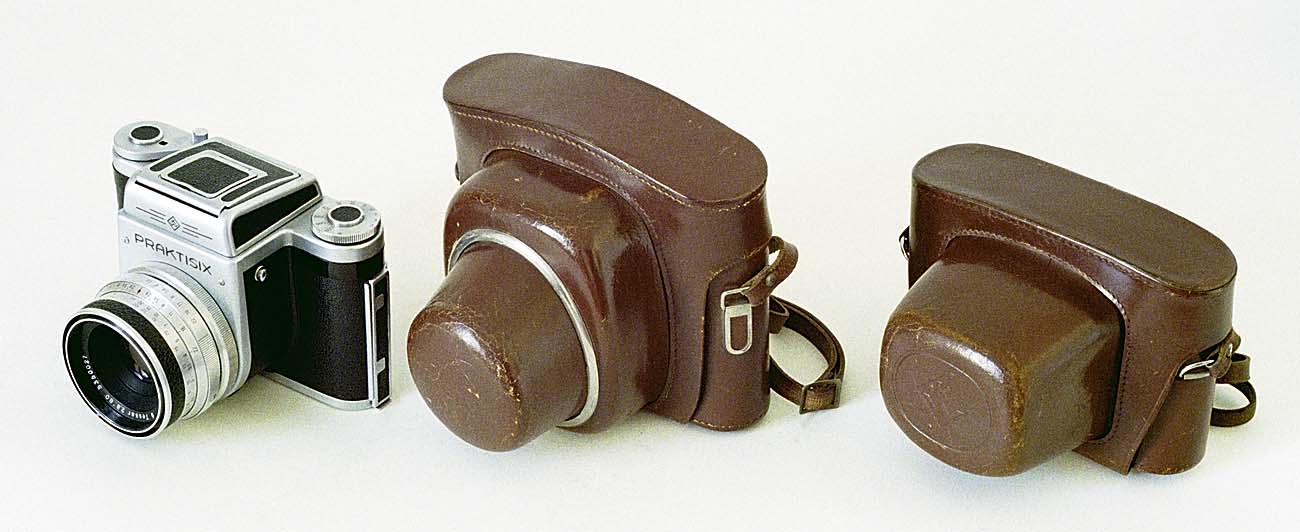
The first case supplied for the
Praktisix looked remarkably
like the case for KW’s top 35mm SLR, the Praktina
(here on the right.)
[C419_28.jpg]
| After the introduction of the
prism, a larger case was
designed, still produced in brown leather in
accordance with the style
of the day. This is essentially the same
as the subsequent standard
Pentacon Six case, lacking only the holes in the
base of the case for the
spool release knobs, which were introduced on a
subsequent model.
The very first prisms had the KW logo. This one has the Pentacon symbol, the Ernemann Tower, as does the front of the case.
|
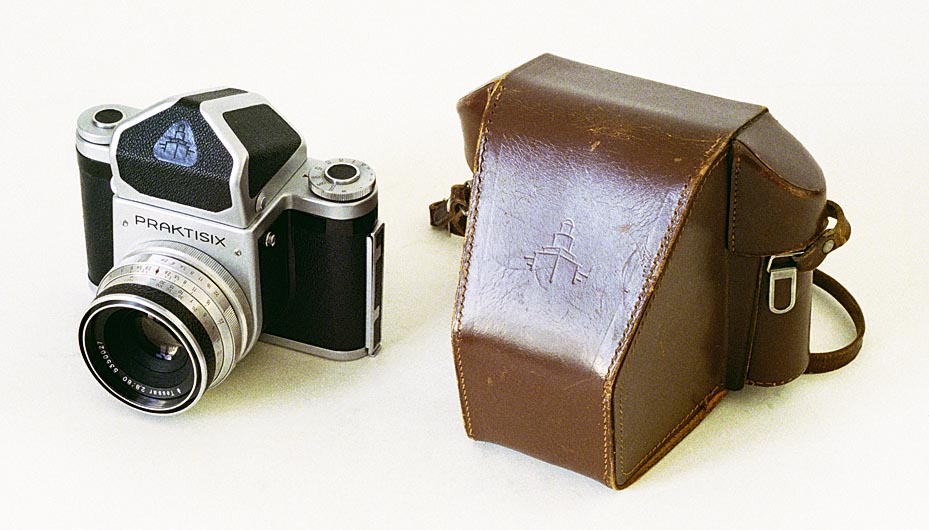
The new “ever-ready” case for the camera with the prism. (This camera has the Carl Zeiss Jena Tessar lens on it.) [C419_29.jpg] |
To go on to the next section, click
below.
17 The Praktisix
II
To go to the beginning of the history section, click here.
To go to introduction to the cameras, click here.
To choose other options, click below.
Home
© TRA August 2010, Revised October 2015